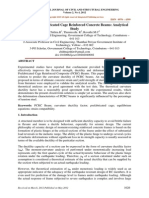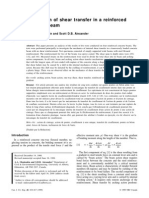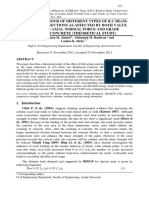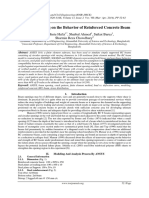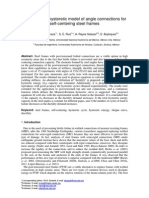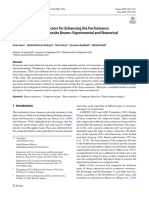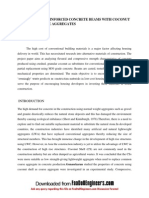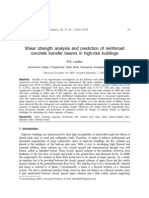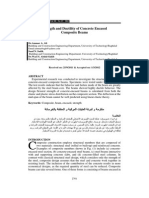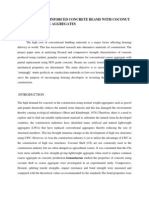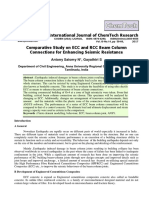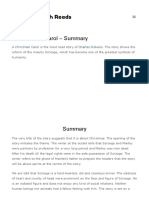Effect of Steel Pins On Interface Shear Behavior of Segmental Concrete Units
Effect of Steel Pins On Interface Shear Behavior of Segmental Concrete Units
Uploaded by
Zahid BhuiyanCopyright:
Available Formats
Effect of Steel Pins On Interface Shear Behavior of Segmental Concrete Units
Effect of Steel Pins On Interface Shear Behavior of Segmental Concrete Units
Uploaded by
Zahid BhuiyanOriginal Title
Copyright
Available Formats
Share this document
Did you find this document useful?
Is this content inappropriate?
Copyright:
Available Formats
Effect of Steel Pins On Interface Shear Behavior of Segmental Concrete Units
Effect of Steel Pins On Interface Shear Behavior of Segmental Concrete Units
Uploaded by
Zahid BhuiyanCopyright:
Available Formats
Effect of Steel Pins on Interface Shear Behavior of Segmental Concrete Units
Md. Zahidul Islam Bhuiyan* Postgraduate student Department of Civil Engineering, University of Malaya, 50603 Kuala Lumpur, Malaysia Email: mdzibhuiyan@gmail.com Faisal Hj Ali Professor Department of Civil Engineering, National Defense University of Malaysia, 57000 Kuala Lumpur, Malaysia Email: fahali@gmail.com Firas A. Salman Senior lecturer Department of Civil Engineering, University of Malaya, 50603 Kuala Lumpur, Malaysia Email: firasalman@hotmail.com Abstract - This study mainly focuses on shear strength behavior of newly and locally produced modular block units with and without steel shear pins. A series of direct shear tests was executed to find out the effectiveness of steel shear pins under different normal loading conditions. Test results were outlined in the form of shear forcedisplacement relationship to compare the influence of shear pins on shear strength behavior. Test results revealed that the presence rigid shear pins reduce the shear strength capacity than a purely frictional condition. Key words: interface shear, rigid pin, segmental block, shear strength, shear connector
1. INTRODUCTION
Geosynthetic reinforced segmental retaining walls (GRSRWs) consisting of polymeric reinforcements and precast modular block units have achieved popularity worldwide in the last three decades because of their many fold advantages. They are frequently used in many geotechnical applications. In Malaysia, the use of dry-stacked column of segmental units as a facing column in retaining wall constructions has been extensively practicing for last decades (Lee, 2000). Today, facing stability is an important issue in the current design guidelines (NCMA, 1997; Elias et al., 2001) and it mainly depends on interface shear and connection failures. Past research works (Soong & Koerner, 1997; Bathurst & Simac, 1993; Buttry et al., 1993) reported that facing instability basically occurs due to poor connection strength and inadequate connection systems. To develop interlocking mechanism between successive vertical courses of units, two different types of shear connections are mainly used in retaining wall constructions. One is built-in mechanical interlock in the form of concrete shear keys or leading/trailing lips and another one is the mechanical connector consisting of pins, clips, or wedges. Mechanical connectors are mainly used to help out unit alignment and control the wall facing batter. Bathurst and Simac (1997) reported that shear connectors (mechanical) or shear keys provide additional interface shear capacity of segmental concrete units. As a shear connector, steel pins (rigid) were used in this research to investigate its effect upon interface shear behavior of infilled units. To evaluate interface shear behaviors or performance parameters, a series of full scale laboratory tests was conducted with and without steel pins (NCMA SRWU-2, 1997; ASTM D 6916-03). Shear force-shear displacement graphs were drawn to compare performance of the infilled concrete units with and without shear pins. Shear capacity envelope graphs were also plotted by using Morh-Coulomb failure criteria under peak and service state criteria.
Corresponding Author: Md. Zahidul Islam Bhuiyan Email: mdzibhuiyan@gmail.com
2. MATERIALS 2.1 Segmental Concrete Unit
In this investigation I blocks were used as segmental concrete units. I blocks are machined mold wet cast concrete units (G 30), which have one center web and the tail/rear flange is extended beyond the web (Fig. 1). The rear flange is tapered that allows the blocks to form curve walls. The maximum tapered angle of the I block is 11.3 deg. I blocks are double open-ended units and make an equivalent hole in conjunction with two units, and the equivalent dimensions are around 450 mm in length, 280 mm in width and 300 mm in height. The infill weight is approximately 93 to 94 kg with the aggregate of bulk density of 1527 kg/m3.The physical and mechanical properties of the used block are outlined in Table 1.
gradation requirements. The physical properties of infill are given in Table 2.
2.3 Steel Bar
Galvanized mild steel round bars were used in the study as mechanical connectors that are generally known as shear connectors. According to the hole dimensions of the segmental concrete units, 12 mm dia bars were selected, and the bars were cut into 125 mm in length. The physical and mechanical properties of the used round steel bars are illustrated in Table 3. Table 2: Physical properties of granular infill. Property Bulk density (kg/m3) Specific gravity Void content (%) Coefficient of gradation, Cc Fineness Modulus (FM) Value 1527 2.63 42 1.15 7.16
Table 3: Physical and mechanical properties of steel bar (Courtesy of AMSteel Mills Sdn Bhd, Malaysia). Property Yield strength (MPa) Modulus of elasticity (MPa) Rolling mass (Kg/m) Cross section area (mm2) Value 347 210000 0.859 113.10
Figure 1: Schematic of used I block. Table 1: Physical and mechanical properties of segmental concrete units. Value 370x300x500 41-42 2166 % 7.1 Water absorption capacity kg/m3 155 Moisture content (%) 3.7 Net compressive strength (MPa) 8.0 * W = Width (Toe to heel), H= Height, L= Length (Parallel to the wall face) Property Dimensions (WxHxL)* in mm Weight (kg) Oven dry density (kg/m3)
3. EXPERIMENTAL DESIGNS 3.1 Test Apparatus
A specially designed and modified large-scale apparatus originally reported by Bathurst and Simac (1993) was used to carry out the performance tests of the I blocks. A photograph of the modified test apparatus is shown in Fig. 2. It is seen that the apparatus was mainly consisting of loading frame, hydraulic actuators, and a fabricated electric hydraulic pump. The vertical actuator was mounted with the loading frame with rollers to allow block movement during the shear test, but in ASTM D 6916-06c test protocol the vertical actuator was kept fixing. The vertical and horizontal actuators were capable of applying around 45 tons of surcharge load and 130 tons of push/pull out force respectively and simultaneously. The electric hydraulic pump was connected to the actuators with pressure hoses, and the pump was capable of delivering flow rate 3 cc per minute. A geosynthetic loading clamp was set with horizontal actuator to apply the tensile load as well as shear load.
2.2 Granular Infill
The hollow cores between the blocks were infilled with 100% crushed limestone aggregate and lightly compacted. The maximum and nominal maximum sizes of the aggregate were 25 and 19 mm, respectively. The particle size distribution of the granular infill meets the lower limit of the NCMA (1997)
Two (2) pressure transducers of 0 to 3,625 psi capacity were mounted over each hydraulic actuator of 150 mm stroke, and the actuators were calibrated by using load cell against the pressure transducers. Two (2) flow regulators (Atos QV06160) were attached with the pump to control the rate of displacement of horizontal (shear) and vertical actuators. The shear displacements were measured using of two 50 mm linear variable displacement transducers (LVDTs) with an accuracy of 0.001mm. Pressure transducers and LVDTs reading were continuously measured and recorded during the test by a data logger. The data were recorded at every 10 second interval.
Pressure transducer Vertical actuator Horizontal actuator
Electric pump
3.2 Interface Shear Tests
Two layers of modular block units were used for interface shear test. The bottom layer/course consisting of two (2) I blocks was installed and braced laterally at the front of loading frame. A single I block was placed centrally over the running joint formed by the two underlying units to simulate the staggered construction procedure used in the field. Two layers of segmental units were connected with shear pins and setback was kept as zero. The hollow sections between the blocks were filled with 19 mm crushed stone aggregate and lightly compacted using a steel rod. To hold the infilled aggregate of top block, two (2) steel plates were used (Fig. 3). Surcharge/normal load was imposed only over the top block through stiff rubber mat and simulated an equivalent height of stacked blocks. The shear load was applied against the top block and immediately above the shear interface to minimize the moment loading at a constant rate of 1 mm/min of the horizontal actuator (ASTM D 6916-03). A steel plate with stiff rubber mat was used with geosynthetic loading clamp to concentrate the shearing load only over the centrally installed top block. A horizontal seating load was applied to the top block to ensure close fitting of the shear pins and after that the load and displacement devices were set to zero. The imposed seating load was 10% of maximum shear strength. Mohr-Coulomb failure criteria were used to find out interface shear capacity at ultimate and service state strength criteria. (1) Where: = Interface shear capacity (kN) = Normal load (kN) = angle of friction (deg.) = interception
Figure 2: Photograph of test apparatus.
Figure 3: Photograph of interface shear test arrangement.
4. TEST RESULTS AND DISCUSSIONS
A series of interface shear tests was performed under a range of normal forces. Shear force - displacement graphs were plotted to evaluate the effects of rigid shear pins on the interface frictional behavior of the tested blocks. Shear capacity envelopes were also drawn to compare the ultimate and service state shear strength of I blocks. Figs. 4(a) and 4(b) compare the magnitude and distribution of shear force with displacement of infilled concrete units. Fig.4 (a) shows the gradually increment of shear force without any pick points that results from the absence of steel pins at joints. In this case, shear force reaches the steady state condition (around 10 kN) after a significant amount of shear displacement. On the other hand, a sudden pick shear force can be seen in Fig. 4(b) prior to serviceability displacement limit and blocks fail quickly at joints (Fig. 6).
The serviceability displacement is identified by vertical dashed line in the graphs, which is around 7 mm according to the block Geometry (2% of the block width). It is also seen that after immediate failure at joints, the shear interface behaves like purely frictional surface and there is no significant rise and fall of shear force with displacement increment rather than near to straight line (Fig. 4(b)). Fig. 4(c) also demonstrates the gradual increment of shear force against shear displacement without any pick points in the curve like Fig. 4(a). Fig. 4(d) reports three (3) repeated tests at almost same surcharge loads, which were controlled using analog pressure controlling valve. Three (3) nominally identical curves also show the accuracy of the performed laboratory tests and the peak shear forces of these tests are less than 10% from the mean of the three tests. The most interesting thing of Fig. 4(d), it is showing two (2) pick points; before and after serviceability line. It happens due to the failure mechanism of concrete blocks at the pin joints. At the time of the experiment, it was observed that one shear pin joint fails first than other because of block irregularity and set up alignments. As a result, shear force increases up to completed failure of both pin joints and drops permanently or becomes a steady state due to aggregate frictions. The test numbers 1 & 2 of Fig. 4(e) illustrate abrupt drops of shear strengths that happen due to sudden relief of frictional contact area of blocks interface like the behavior of tectonic plates. From the Fig. 4(f), it is seen that the steady state shear strength of pins connected infilled blocks reduce to about 15 kN that is less than the purely frictional condition (Fig. 4(e)). It occurs due to the stress concentration at the connection joints, which accelerate the failures of blocks at the flange area (Fig. 6(b)). As a result, the failure interface areas of blocks become loose enough and unable to carry shear force that causes to reduce interface shear strength at the high surcharge load conditions. The same behaviors are also observed in Fig. 4 (h) with respect to Fig. 4(g). The curve of Fig. 4(g) is wavier than others purely frictional graphs that result from a high surcharge load. The increment of normal load makes stress concentrations at different contact points of interface, which leads to rise and fall of shear force with the mobilization of blocks. The data presented in the Figs. 5(a) & 5(b) illustrates the influence of steel shear pins on shear capacity envelopes. It is clear from the Fig. 5(b) that shear pins provide more apparent cohesion (normal force-independent strength) than purely frictional block systems (Fig. 5(a)) at the ultimate condition, although the angle of internal friction is less. Bathurst and Simac (1994), and Bathurst et al. (2008) reported the same behaviors with different types of block geometries and shear connectors. The frictional interface area is a complex surface
consisting of block-block, block-infill, and infill-infill contact areas. The presence of steel shear pins in running bond causes immediately failures (spalling/cracks) in the block-block contact areas, which results in the reduction of concrete contact areas (Fig. 6). As a result, angle of internal friction becomes lower than purely frictional interface systems. Fig. 5(b) reports no serviceability capacity envelope due to the presence of steel pins in the connection system that breaks the blocks before reaching the serviceability limit. So it can be said that this connection system is not effective for service state design of segmental retaining walls with I blocks. As an alternative of steel pins, plastic pins may be used and investigated its effect on interface behavior.
5. CONCLUSIONS
This study investigates the results of interface shear testing executed to find out the effect of steel shear pins on frictional behavior of newly fabricated and modified I blocks. In this research, a series of interface shear tests was performed under several conditions. The following conclusions can be drawn based on the results: 1. Steel shear pins initially increase shear force but after immediate failure at the joints shear force decrease to purely frictional shear force of infilled blocks or less than that. Purely frictional behavior of infilled blocks is very smooth and steadier than infilled blocks with steel pins. Purely frictional systems easily govern service state criterion but the systems with steel pins are unable to follow that criterion. Steel bar is stiffer than concrete, as a result concrete fails easily at the connections prior to any significant shear displacement to mobilize shear strength. So, it is important to find out effective flexible shear connectors that give significant shear displacement as well as shear strength.
2.
3.
4.
30 25 20 15 10 5 Normal force = 8.71kN 0 0 5 10 15 20 25 Shear displacement (mm)
30 25 20 15 10 5 Normal force = 8.13 kN 0 0 5 10 15 20 25 Shear displacement (mm)
Shear force (kN)
Shear force (kN)
(b) (a)
30 25 20 15 10 5 0 0 5 10 15 20 25 Shear Displacement (mm)
30 25 20 15 10 5 Normal force = 12.66 kN Normal force = 12.55 kN Normal force = 12.57 kN 0 5 10 15 20 25
Shear force (kN)
Normal force = 12.58 kN
0
Shear force (kN)
Shear displacement (mm)
(c)
30 25 20 15 10 5 0 0 5 10 15 20 25 Shear Displacement (mm) Normal force = 18.22 kN Normal force = 18.18 kN Normal force = 18.05 kN
30 25 20 15 10 5
(d)
Shear force (kN)
Shear force (kN)
Normal force = 18.03 kN 0 0 5 10 15 20 25 Shear displacement (mm)
(e)
30 25 20 15 10 5 0 0 5 10 15 20 25 Shear Displacement (mm)
30 25 20 15 10 5
(f)
Shear force (kN)
Normal force = 23.55 kN
Shear force (kN)
Normal force = 23.37 kN 0 0 5 10 15 20 25 Shear displacement (mm)
(g)
(h)
Figure 4: Shear force-displacement curves with (b, d, f, and h) and without (a, c, e and g) shear pins.
40
40
Vp N tan 43.03 4.47
Peak capacity
30
Vp N tan 32.20 7.89
30
Peak capacity
Shear force (kN)
20
Shear force (kN)
20
10
Capacity @ 7 mm displacement
10
Vs N tan 44.11
0 0 10 20 Normal force (kN) 30 40
0 0 10 20 Normal force (kN) 30 40
(a)
(b)
Figure 5: Shear capacity envelopes of I blocks (a) without and (b) with steel pins. Proceedings of ASTM Symposium on Geosynthetic Soil Reinforcement Testing, San Antonio, Texas, USA. Bathurst, R. J. & Simac, M. R. (1994) Geosynthetic reinforced segmental retainingwall structures in North America. Proceedings of the Fifth International Conference on Geotextiles, Geomembranes and Related Products, Singapore, 1-41. Bathurst, R. J., and Simac, M.R. (1997) Design and performance of the facing column for geosynthetic reinforced segmental retaining walls. In J. W. Balkema, (ed), International symposium on mechanically stabilized backfill. Denver, Colorado. Bathurst, R. J., Althoff, S. and Linnenbaum, P. (2008) Influence of test method on direct shear behavior of segmental retaining wall units, Geotechnical Testing Journal, 31, 1-9. Elias, V., Christopher, B. R., and Berg, R. R. (2001) Mechanically stabilized earth walls and reinforced soil slopes "Design & construstion guidelines", FHWA-NHI-00-043, Washington D.C., National Highway Institute. Lee, C. H. (2000) Design and construction of a 9.6m high segmental wall. Proceedings of Secend Asian geosynthetics conference, Kuala Lumpur, Malaysia. NCMA (1997) Design manual for segmental retaining walls, Herndon, Virginia, National Concrete Masonry Association (NCMA). Soong, T. Y., and Koerner, R.M. (1997) On the required connection strength of geosynthetically reinforced walls, Geotextiles and Geomembranes, 15, 377- 393.
(b) (a)
(c) Figure 6: Photographs of common failure patterns at joints (a) Spalling at bottom blocks, (b) spalling at top block, and (c) Triangular crack at bottom block.
REFERENCES
ASTM D 6916-03 Standard test method for determining the shear strength between segmental concrete units, West Conshohocken, PA, USA, ASTM International. ASTM D 6916-06c Standard test method for determining the shear strength between segmental concrete units, West Conshohocken, PA, USA, ASTM International. Buttry, K. E., Mccullough, E. S., and Wetzel, R. A. (1993) Laboratory evaluation of connection strength of geogrid to segmental concrete units, Washington, DC 20001 USA. Bathurst, R. J., and Simac, M.R. (1993) Laboratory testing of modular concrete block - geogrid facing connections.
AUTHOR BIOGRAPHIES Md. Zahidul Islam Bhuiyan is a postgraduate student at the Department of Civil Engineering, Faculty of Engineering, University of Malaya, and Malaysia. He graduated from the Department of Civil Engineering at Bangladesh University of Engineering and Technology (BUET), Bangladesh in 2009. His research interests include geotechnical engineering. He can be reached at mdzibhuiyan@gmail.com. Faisal Hj Ali is a professor at the Department of Civil Engineering, Faculty of Engineering, National Defense, and Malaysia. He received a doctoral degree in Geotechnical Engineering from University of Sheffield, United Kingdom in 1984. His teaching and research interests include unsaturated residual soils, ground improvement techniques, slope instability, foundation engineering, and reinforced earth. He can be reached at fahali@gmail.com. Firas A. Salman is a senior lecturer at the Department of Civil Engineering, Faculty of Engineering, University of Malaya, and Malaysia. He received a doctoral degree in Geotechnical Engineering from Baghdad University, Iraq. His teaching and research interests include foundation analysis & design, soil investigation, and ground improvement. He can be reached at firasalman@hotmail.com.
You might also like
- Reinforced Concrete Buildings: Behavior and DesignFrom EverandReinforced Concrete Buildings: Behavior and DesignRating: 5 out of 5 stars5/5 (1)
- A Case of IdentityDocument10 pagesA Case of IdentityAngela WilliamsNo ratings yet
- Chapters 11 & 13 Individual Quiz - AnswersDocument7 pagesChapters 11 & 13 Individual Quiz - AnswersAlec DNo ratings yet
- Faisal HJ Ali, Md. Zahidul Islam Bhuiyan and Firas SalmanDocument8 pagesFaisal HJ Ali, Md. Zahidul Islam Bhuiyan and Firas SalmanZahid BhuiyanNo ratings yet
- Performance Criteria For Dissipative Steel Plate Shear Walls StructuresDocument8 pagesPerformance Criteria For Dissipative Steel Plate Shear Walls StructuresgiorgosantzelidisNo ratings yet
- Wcee2012 4133Document10 pagesWcee2012 4133toyi kamiNo ratings yet
- Ductility of Prefabricated Cage Reinforced Concrete Beams: Analytical StudyDocument9 pagesDuctility of Prefabricated Cage Reinforced Concrete Beams: Analytical StudymagdyamdbNo ratings yet
- Chapter 2 Literature ReviewDocument10 pagesChapter 2 Literature ReviewSharan BvpNo ratings yet
- Randl 2018Document8 pagesRandl 2018isabela erenoNo ratings yet
- Punching Shear Resistance of SlabDocument8 pagesPunching Shear Resistance of SlablinkgreencoldNo ratings yet
- Cyclic Behaviour of Beam Column Joint Retrofitted With Simcon LaminatesDocument20 pagesCyclic Behaviour of Beam Column Joint Retrofitted With Simcon LaminatesJay PatelNo ratings yet
- Effect of Beam Dimensions On Structural Performance of Wide Beam-Column JointsDocument7 pagesEffect of Beam Dimensions On Structural Performance of Wide Beam-Column JointsRafa SouzaNo ratings yet
- Structural Performance of Bolted Connectors in Retrofitted Transmission Tower Leg MembersDocument12 pagesStructural Performance of Bolted Connectors in Retrofitted Transmission Tower Leg MembersFeleki AttilaNo ratings yet
- Mechanism of Shear TransferDocument8 pagesMechanism of Shear TransferSana'a AamirNo ratings yet
- Composites: Part B: Z.L. Wang, Z.M. Shi, J.G. WangDocument6 pagesComposites: Part B: Z.L. Wang, Z.M. Shi, J.G. WangPriyanka JainNo ratings yet
- Redzuan Abdullah, Vidal P. Paton-Cole, W. Samuel Easterling, F.AsceDocument13 pagesRedzuan Abdullah, Vidal P. Paton-Cole, W. Samuel Easterling, F.AsceshardasiddhNo ratings yet
- Effect of Depth To Thickness Ratio and Length To Depth Ratio On Hollow Section Aluminium Tubes Filled With Self Compacting ConcreteDocument4 pagesEffect of Depth To Thickness Ratio and Length To Depth Ratio On Hollow Section Aluminium Tubes Filled With Self Compacting ConcreteInternational Journal of Research in Engineering and Technology100% (1)
- 97 - J - 6060 1Document44 pages97 - J - 6060 1Marimuthu KaliyamoorthyNo ratings yet
- Hybrid Precast Concrete Column and Sandwich Concrete Beam Under Static LoadingDocument13 pagesHybrid Precast Concrete Column and Sandwich Concrete Beam Under Static LoadingRohan ReddyNo ratings yet
- Experimental Investigations On CompressiDocument18 pagesExperimental Investigations On Compressiyaj leumas seyerNo ratings yet
- Effects of Opening On The Behavior of Reinforced Concrete Beam I011275261Document10 pagesEffects of Opening On The Behavior of Reinforced Concrete Beam I01127526101010No ratings yet
- Vertical Post-Tensioned Connection For Modular Steel BuildingsDocument8 pagesVertical Post-Tensioned Connection For Modular Steel Buildings1newlight1No ratings yet
- Numerical Study of Reinforced Concrete Beam Subjected To Blast Loading Using Finite Element Package ABAQUSDocument4 pagesNumerical Study of Reinforced Concrete Beam Subjected To Blast Loading Using Finite Element Package ABAQUSJangdiniNo ratings yet
- Apendice C PDFDocument19 pagesApendice C PDFRoosevelt Mamani QuispeNo ratings yet
- Finite Element Study of Using Concrete Tie Beams To Reduce Differential Settlement Between FootingsDocument5 pagesFinite Element Study of Using Concrete Tie Beams To Reduce Differential Settlement Between FootingsrbalmodalNo ratings yet
- Progressive Collapse AnalysisDocument21 pagesProgressive Collapse AnalysisForsythe LearningNo ratings yet
- Use of Steel Fiber Reinforced Concrete For Enhanced Performance of Deep Beams With Large OpeningsDocument10 pagesUse of Steel Fiber Reinforced Concrete For Enhanced Performance of Deep Beams With Large OpeningssuhagNo ratings yet
- Effect of Corrosion On Performance of Reinforced Concrete Structure UsingDocument4 pagesEffect of Corrosion On Performance of Reinforced Concrete Structure UsingSyed SohailNo ratings yet
- Deep BeamDocument9 pagesDeep BeamDeana WhiteNo ratings yet
- The Use of Shear Connectors For Enhancing The Performance of Steel-Concrete Composite Beams: Experimental and Numerical AssessmentDocument11 pagesThe Use of Shear Connectors For Enhancing The Performance of Steel-Concrete Composite Beams: Experimental and Numerical AssessmentMALIKNo ratings yet
- 1Document13 pages1ihpeterNo ratings yet
- Behaviour of Reinforced Concrete Beams With Coconut Shell As Coarse AggregatesDocument8 pagesBehaviour of Reinforced Concrete Beams With Coconut Shell As Coarse AggregatesUmair BaigNo ratings yet
- Influence of Selected Parameters On Design Optimisation of Anchor JointDocument10 pagesInfluence of Selected Parameters On Design Optimisation of Anchor JointMiguel Rivera100% (1)
- Coneccion Ansys DisipadorDocument8 pagesConeccion Ansys DisipadorHectoreRodriguezlNo ratings yet
- Cyclic Strut & Tie Modelling of Simple Reinforced Concrete StructuresDocument8 pagesCyclic Strut & Tie Modelling of Simple Reinforced Concrete StructuresGloomsyNo ratings yet
- Numerical Estimation and Analysis of Effective Width of Composite Beams With Ribbed SlabDocument15 pagesNumerical Estimation and Analysis of Effective Width of Composite Beams With Ribbed SlabInternational Journal of Application or Innovation in Engineering & ManagementNo ratings yet
- Paper 7Document9 pagesPaper 7RakeshconclaveNo ratings yet
- Jacketing of Column 122Document6 pagesJacketing of Column 122solomonceNo ratings yet
- Shear Strength Analysis and Prediction of Reinforced Concrete Transfer Beams in High-Rise BuildingsDocument21 pagesShear Strength Analysis and Prediction of Reinforced Concrete Transfer Beams in High-Rise Buildingsmohammed_fathelbabNo ratings yet
- Combe and Hartig 2006Document10 pagesCombe and Hartig 2006Komathi MuruganNo ratings yet
- Structure and Construction Examples of Tunnel Reinforcement Method Using Thin Steel PanelsDocument6 pagesStructure and Construction Examples of Tunnel Reinforcement Method Using Thin Steel PanelsMohamed H. JiffryNo ratings yet
- Encased ColumnsDocument14 pagesEncased ColumnsjimmyfontanaNo ratings yet
- Experimental Research On Seismic Behavior of Unbonded Precast Reinforced Concrete FrameDocument5 pagesExperimental Research On Seismic Behavior of Unbonded Precast Reinforced Concrete FrameRohan ReddyNo ratings yet
- Mani - Project (Coconut Shell)Document8 pagesMani - Project (Coconut Shell)maniengg100% (1)
- A Parametric Study of R.C. Slab in Beam-Column Connection Under Cyclic LoadingDocument9 pagesA Parametric Study of R.C. Slab in Beam-Column Connection Under Cyclic Loadingمحمد تانزيم ابراهيمNo ratings yet
- Machine Tool Structures PDFDocument10 pagesMachine Tool Structures PDFMohan Nanjan S50% (2)
- Design of Anchor Plates Based On The Component Method Rybinski & KulhmannDocument12 pagesDesign of Anchor Plates Based On The Component Method Rybinski & KulhmannvcKampNo ratings yet
- International Journal of Chemtech Research: Antony Salomy N, Gayathiri SDocument9 pagesInternational Journal of Chemtech Research: Antony Salomy N, Gayathiri Sci_balaNo ratings yet
- Static Behavior of Planar Intersecting CFST Connection in Diagrid StructureDocument11 pagesStatic Behavior of Planar Intersecting CFST Connection in Diagrid Structuresameh lotfyNo ratings yet
- Artigo 2Document6 pagesArtigo 2Edmilson LimaNo ratings yet
- Published 10.1201 - 9780429426506-204 PDFDocument5 pagesPublished 10.1201 - 9780429426506-204 PDFMohammad Ali MahdavipourNo ratings yet
- Experimental Study of The Effect of Triaxiality RatioDocument4 pagesExperimental Study of The Effect of Triaxiality RatioEl Ehsan Abinya FatihNo ratings yet
- Torsion of High-Strength Reinforced Concrete Beams and Minimum Reinforcement RequirementDocument8 pagesTorsion of High-Strength Reinforced Concrete Beams and Minimum Reinforcement RequirementSuhas Natu100% (1)
- Esperimental StudyDocument9 pagesEsperimental Studyrafaelrp22009No ratings yet
- NJIT Research Project On Composite Floor Systesm-Presentation-092512Document24 pagesNJIT Research Project On Composite Floor Systesm-Presentation-092512pedrormunozNo ratings yet
- Aluminium Shear-Links For Enhanced Seismic Resistance: Earthquake Engng. Struct. Dyn. 27, 315-342 (1998)Document28 pagesAluminium Shear-Links For Enhanced Seismic Resistance: Earthquake Engng. Struct. Dyn. 27, 315-342 (1998)smootherboyNo ratings yet
- Behaviour and Strength of Composite Slabs With Ribbed DeckingDocument19 pagesBehaviour and Strength of Composite Slabs With Ribbed DeckingRoberval PimentaNo ratings yet
- Reinforced High-Strength Concrete Beams in FlexureDocument11 pagesReinforced High-Strength Concrete Beams in FlexureAndrei IancuNo ratings yet
- Composite Structures of Steel and Concrete: Beams, Slabs, Columns and Frames for BuildingsFrom EverandComposite Structures of Steel and Concrete: Beams, Slabs, Columns and Frames for BuildingsNo ratings yet
- (Law and Practical Reason) Stefano Bertea - The Normative Claim of Law (2009, Hart Publishing)Document316 pages(Law and Practical Reason) Stefano Bertea - The Normative Claim of Law (2009, Hart Publishing)msilva_822508No ratings yet
- Differential Equations in Matlab-II: Riddhi@civil - Iitb.ac - inDocument45 pagesDifferential Equations in Matlab-II: Riddhi@civil - Iitb.ac - inVinay MauryaNo ratings yet
- RTB FP 03 006 Despatch Loading BinDocument1 pageRTB FP 03 006 Despatch Loading BinSeapara SathekgeNo ratings yet
- Philippine Integrated Disease Surveillance and Response: Admitted in Multiple Health FacilitiesDocument5 pagesPhilippine Integrated Disease Surveillance and Response: Admitted in Multiple Health FacilitiesVanzNo ratings yet
- 10 Principles of EconomicsDocument2 pages10 Principles of EconomicsEmmanuella Affiong EtukNo ratings yet
- Almanacs 45001Document176 pagesAlmanacs 45001gorgeriderNo ratings yet
- Electrical Area Classification NFPA 30Document2 pagesElectrical Area Classification NFPA 30mohamed abd el maksoudNo ratings yet
- Unit 1 (WB)Document12 pagesUnit 1 (WB)Lê Thảo VyNo ratings yet
- Clinical Evaluation Tool Revised 8 12Document6 pagesClinical Evaluation Tool Revised 8 12Kirandeep ParmarNo ratings yet
- Scheduling Proportional ShareDocument11 pagesScheduling Proportional ShareminniNo ratings yet
- Chapter-1 The Lost ChildDocument5 pagesChapter-1 The Lost ChildVinodhini GnanaprakasamNo ratings yet
- 12 Biology Semester ExamDocument15 pages12 Biology Semester ExamGeorge TarraNo ratings yet
- Tooth Discoloration: DR Bindu Kumari (BDS)Document32 pagesTooth Discoloration: DR Bindu Kumari (BDS)محمد العراقيNo ratings yet
- Letter To Parents - Case StudyDocument2 pagesLetter To Parents - Case StudyFranz Allen RanasNo ratings yet
- KMBN 106 Design ThinkingDocument27 pagesKMBN 106 Design ThinkingFaisal Arif100% (1)
- Haver Standard (HAST) Wiremesh BrochureDocument4 pagesHaver Standard (HAST) Wiremesh BrochureRama DitasuwitaNo ratings yet
- Case Comment On Indian Young Lawyers Association V. The State of KeralaDocument19 pagesCase Comment On Indian Young Lawyers Association V. The State of KeralaKrishna Ahuja100% (1)
- A Christmas Carol by Charles Dickens - SummaryDocument8 pagesA Christmas Carol by Charles Dickens - SummaryAhmed Mohmud100% (2)
- 04 Grain Drying Principles and SystemsDocument74 pages04 Grain Drying Principles and SystemsJanu MaglenteNo ratings yet
- Ecr Elementary 1 3 Q1Document50 pagesEcr Elementary 1 3 Q1Charm BaylonNo ratings yet
- How To Start A BlogDocument4 pagesHow To Start A BlogmaroNo ratings yet
- Leader in Innovative Packaging Solutions: Process Operating ManualDocument11 pagesLeader in Innovative Packaging Solutions: Process Operating ManualLyonelNo ratings yet
- Cell MembraneDocument15 pagesCell MembraneAyesha SaleemNo ratings yet
- Main Controller Tech Manual 04Document28 pagesMain Controller Tech Manual 04Khalil Issaad100% (4)
- Detailed Lesson Plan in Eng10Document6 pagesDetailed Lesson Plan in Eng10justine07No ratings yet
- StudentDocument24 pagesStudentfatinNo ratings yet
- IR - Jawaban Pertanyaan OlerDocument2 pagesIR - Jawaban Pertanyaan OlerIndra RamadhanyNo ratings yet






